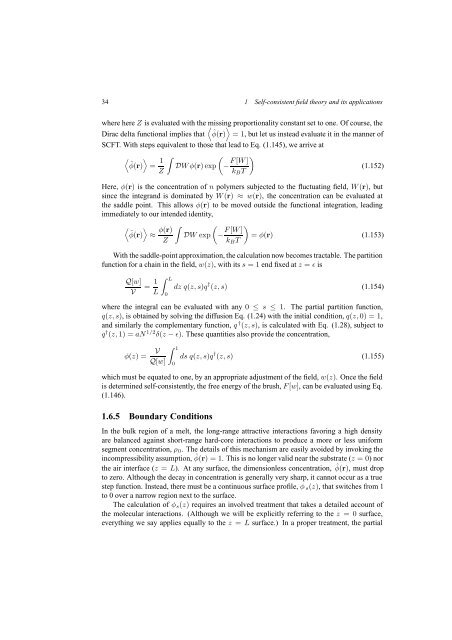Self-Consistent Field Theory and Its Applications by M. W. Matsen
Self-Consistent Field Theory and Its Applications by M. W. Matsen
Self-Consistent Field Theory and Its Applications by M. W. Matsen
You also want an ePaper? Increase the reach of your titles
YUMPU automatically turns print PDFs into web optimized ePapers that Google loves.
34 1 <strong>Self</strong>-consistent field theory <strong>and</strong> its applications<br />
where here Z is evaluated with the missing 〉 proportionality constant set to one. Of course, the<br />
Dirac delta functional implies that<br />
〈ˆφ(r) =1, but let us instead evaluate it in the manner of<br />
SCFT. With steps equivalent to those that lead to Eq. (1.145), we arrive at<br />
〉 〈ˆφ(r) = 1 ∫<br />
(<br />
DWφ(r)exp − F [W ] )<br />
(1.152)<br />
Z<br />
k B T<br />
Here, φ(r) is the concentration of n polymers subjected to the fluctuating field, W (r), but<br />
since the integr<strong>and</strong> is dominated <strong>by</strong> W (r) ≈ w(r), the concentration can be evaluated at<br />
the saddle point. This allows φ(r) to be moved outside the functional integration, leading<br />
immediately to our intended identity,<br />
〈ˆφ(r)<br />
〉<br />
≈ φ(r)<br />
Z<br />
∫<br />
DW exp<br />
(<br />
− F [W ] )<br />
k B T<br />
= φ(r) (1.153)<br />
With the saddle-point approximation, the calculation now becomes tractable. The partition<br />
function for a chain in the field, w(z), with its s =1end fixed at z = ɛ is<br />
Q[w]<br />
V<br />
= 1 L<br />
∫ L<br />
0<br />
dz q(z,s)q † (z,s) (1.154)<br />
where the integral can be evaluated with any 0 ≤ s ≤ 1. The partial partition function,<br />
q(z,s), is obtained <strong>by</strong> solving the diffusion Eq. (1.24) with the initial condition, q(z,0) = 1,<br />
<strong>and</strong> similarly the complementary function, q † (z,s), is calculated with Eq. (1.28), subject to<br />
q † (z,1) = aN 1/2 δ(z − ɛ). These quantities also provide the concentration,<br />
φ(z) =<br />
V<br />
Q[w]<br />
∫ 1<br />
0<br />
ds q(z,s)q † (z,s) (1.155)<br />
which must be equated to one, <strong>by</strong> an appropriate adjustment of the field, w(z). Once the field<br />
is determined self-consistently, the free energy of the brush, F [w], can be evaluated using Eq.<br />
(1.146).<br />
1.6.5 Boundary Conditions<br />
In the bulk region of a melt, the long-range attractive interactions favoring a high density<br />
are balanced against short-range hard-core interactions to produce a more or less uniform<br />
segment concentration, ρ 0 . The details of this mechanism are easily avoided <strong>by</strong> invoking the<br />
incompressibility assumption, ˆφ(r) =1. This is no longer valid near the substrate (z =0) nor<br />
the air interface (z = L). At any surface, the dimensionless concentration, ˆφ(r), must drop<br />
to zero. Although the decay in concentration is generally very sharp, it cannot occur as a true<br />
step function. Instead, there must be a continuous surface profile, φ s (z), that switches from 1<br />
to 0 over a narrow region next to the surface.<br />
The calculation of φ s (z) requires an involved treatment that takes a detailed account of<br />
the molecular interactions. (Although we will be explicitly referring to the z =0surface,<br />
everything we say applies equally to the z = L surface.) In a proper treatment, the partial
















